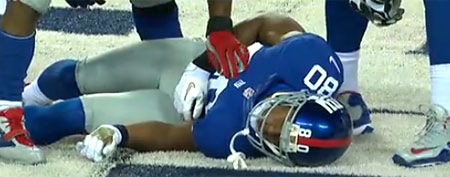
Every borderline hit in the NFL is watched repeatedly,
for clues on whether a hit is vicious and dirty and a threat to player
safety, or just part of a sometimes violent game.
Did the defensive player hit with his shoulder or helmet? Did he aim
at the offensive player's head? Is a shot below the neck good and legal,
or is it worth a penalty (and perhaps more, because the league office
is going to watch the hit a few times as well) because the offensive
player was defenseless?CBS showed Pittsburgh safety Ryan Clark's hit on Giants receiver Victor Cruz repeatedly after it happened, looking for answers. Clark was given a 15-yard penalty for his hit on Cruz in the end zone, which happened right after Pittsburgh batted down a pass on third down. The Giants took advantage of the automatic first down and scored a touchdown.
The replay just brought about more ambiguity.
Clark didn't go for Cruz's head, nor did he use his head to strike the blow. He used his shoulder to hit Cruz in the ribs. Cruz was hurt on the play (he did return soon after) but that doesn't make it illegal. And the batted pass technically hadn't touched the ground when Clark delivered the hit.
But it's also very clear that Clark was looking to inflict pain on a receiver that wasn't in position to defend himself. He honed in on Cruz in the end zone, saw an opportunity to strike when Cruz wasn't looking, and hammered him. It's hard to watch Clark through the play and not come to the conclusion that his only intention was to hit a vulnerable receiver who realistically had no chance to catch the ball after Ike Taylor batted it away and had no idea Clark was coming. The hit was, at very least, unnecessary.
CBS color commentator Phil Simms seemed to think Clark didn't deserve a flag because he didn't use his head when he hit Cruz. Look at the replay again. And maybe watch it a few more times after that. There's unlikely to be a consensus answer no matter how many times we see it.








0 comments:
Post a Comment